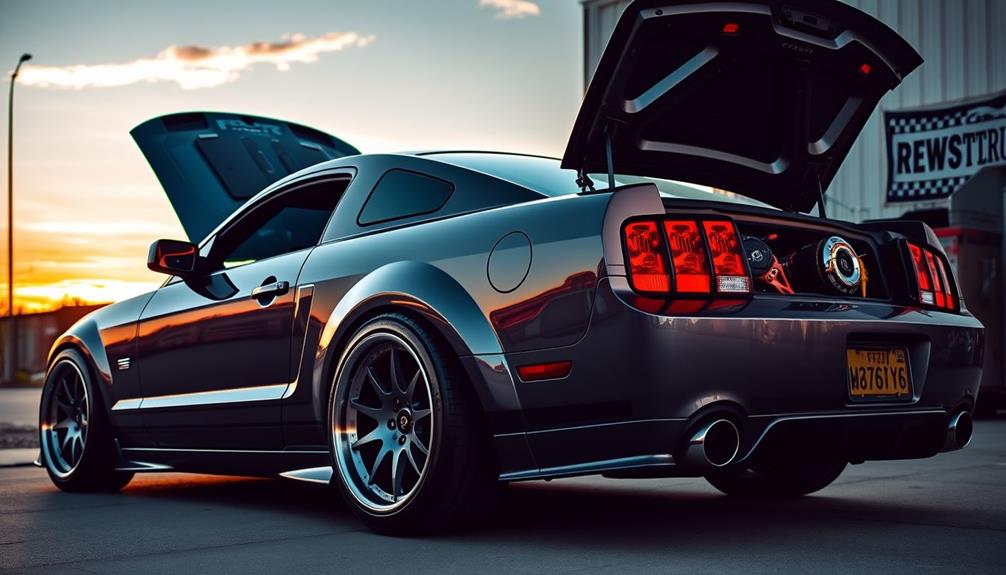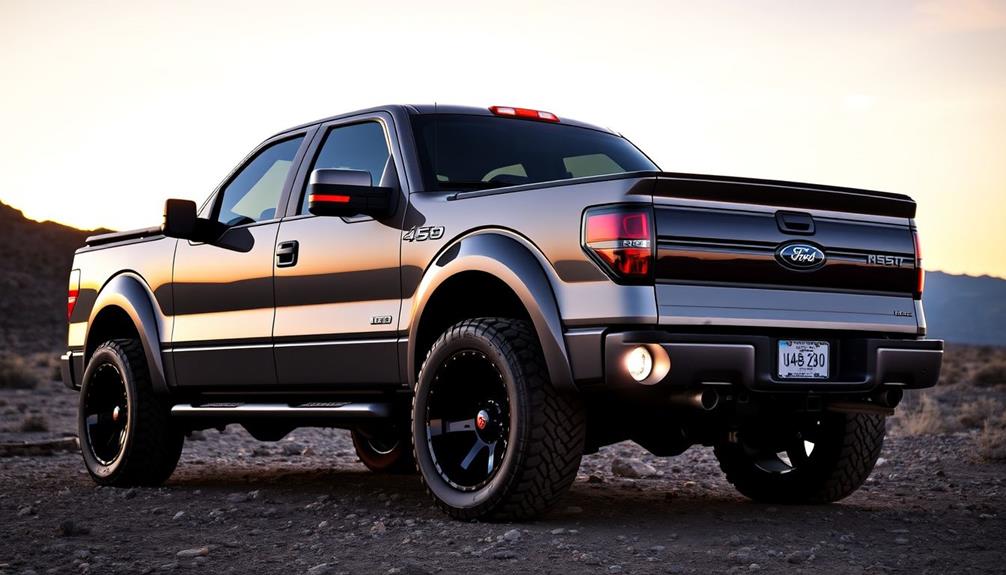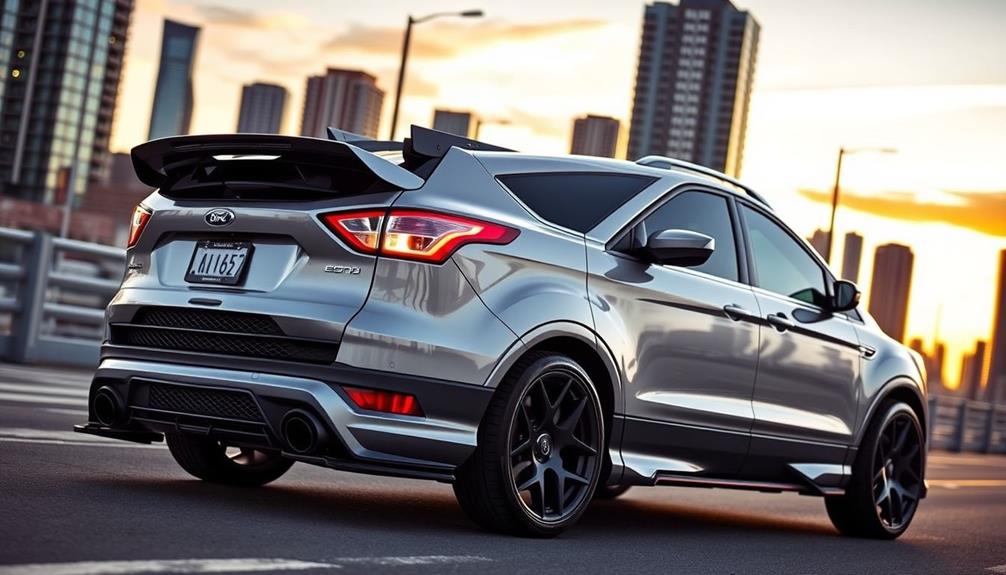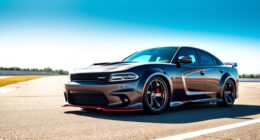Tuning your 1988 Ford Ranger can greatly enhance its performance, turning it into a modern powerhouse. Start by upgrading to a 2.3L engine for improved torque and horsepower. Adding a Weber 32-36 carburetor and K&N air filter boosts fuel delivery and engine breathing. Don't forget exhaust improvements—aftermarket headers and a Cherry Bomb muffler deliver better flow and a sportier sound. These modifications can elevate your classic pickup's responsiveness and efficiency while keeping it reliable. If you're enthusiastic to access even more potential, there's plenty more to explore in the world of Ranger tuning.
Key Takeaways
- Upgrade to a 2.3L non-EFI engine for enhanced horsepower and torque, boosting overall performance.
- Install a Weber 32-36 carburetor to improve fuel delivery and engine responsiveness.
- Use aftermarket headers and a Cherry Bomb muffler to enhance exhaust flow and sound.
- Consider adding performance cams for maximum power output and better driving experience.
- Engage with online forums for insights and shared experiences on tuning the 1988 Ford Ranger.
Overview of the 1988 Ranger
The 1988 Ford Ranger often stands out as a solid choice for those seeking a no-frills, reliable truck. This model was primarily designed for basic, low-performance capabilities, featuring a 2.0L straight 4 carb engine that produces around 72 horsepower. While some may find this power lacking, the Ranger's durability and sturdy construction quickly become its defining traits.
You'll appreciate how owners report minimal damage even after significant accidents, proving its reliability.
Equipped with a 5-speed manual transmission, the Ranger delivers a straightforward driving experience that many drivers enjoy. An upgrade to a 2.3L engine was introduced in 1988, offering better fuel efficiency and performance—achieving 2 mpg better than the 2.0L according to EPA figures.
Although the truck originally came as a zero-option vehicle, the XLT interior offered some improvements, including a cloth bench seat and basic radio, while still lacking power accessories like air conditioning.
In essence, if you're looking for a classic truck that delivers both reliability and simplicity, the 1988 Ford Ranger is a commendable choice. It's ready to tackle daily tasks without the fuss of modern upgrades.
Essential Performance Modifications

When it comes to boosting your 1988 Ranger's performance, focusing on exhaust flow and air intake is key.
Upgrading to aftermarket headers and a Cherry Bomb muffler can greatly enhance exhaust efficiency, while a K&N air filter improves air intake.
These essential modifications not only increase horsepower but also elevate your truck's overall performance.
Exhaust Flow Improvements
Notable improvements in exhaust flow can release your Ford Ranger's true performance potential. One of the most effective ways to achieve this is by replacing the factory headers with aftermarket headers. These headers are designed to enhance exhaust flow, allowing your engine to breathe better and ultimately boosting its performance and efficiency.
Another great modification is installing a Cherry Bomb muffler. Not only does it give your Ranger a sportier sound, but it also optimizes exhaust flow, contributing to overall power gains.
If you're looking for more considerable upgrades, consider swapping in a 2.3L non-EFI engine. This engine is compatible with performance headers, offering better torque and horsepower than the original 2.0L.
Additionally, upgrading to a Weber 32-36 2-barrel carburetor can markedly improve fuel delivery, working harmoniously with your enhanced exhaust system.
For a complete setup, don't forget to add a K&N air filter. It complements your exhaust upgrades by improving the engine's breathing capabilities.
Together, these modifications can transform your 1988 Ford Ranger into a powerful, efficient classic pickup with modern performance.
Air Intake Enhancements
Enhancing your Ford Ranger's air intake is crucial for releasing its performance potential. Start by installing a high-quality K&N air filter, which can considerably boost air intake efficiency. This upgrade guarantees better combustion, leading to improved engine performance in your 2.0L engine.
Next, consider replacing the factory air intake system with a Cold Air Intake (CAI). A CAI allows cooler air to enter the engine, optimizing horsepower and torque through more efficient airflow.
Pair this with a Weber 32-36 2-barrel carburetor for enhanced fuel delivery. This combination not only increases power but also improves throttle response, making your Ranger feel more responsive on the road.
If you're looking to take it a step further, utilize a 2-barrel intake manifold from a Pinto. This modification can optimize the air-fuel mixture entering the engine, further boosting performance.
Exploring Engine Swap Options

When considering an engine swap for your 1988 Ranger, you'll want to think about compatibility and what performance gains you can achieve.
Understanding the installation challenges is essential, as they can impact the overall success of your project.
Let's explore these aspects to help you make an informed decision.
Engine Compatibility Considerations
While considering an engine swap for your 1988 Ford Ranger, it's vital to evaluate compatibility with existing components to guarantee a smooth upgrade. The original 2.0L straight 4 carb engine can benefit considerably from a swap to a 2.3L non-EFI engine sourced from 1983-1985 models. This upgrade can deliver improved torque and horsepower, enhancing your overall driving experience.
When planning your engine swap, think about how different components will work together. For instance, utilizing exhaust headers from other Ranger models or 4-cylinder Mustangs can greatly enhance exhaust flow, complementing your new engine's performance.
Additionally, incorporating a 2-barrel intake manifold from a Pinto can give your upgraded 2.3L engine a notable performance boost.
Don't forget about the fuel delivery system; a Weber 32-36 2-barrel carburetor is highly recommended for peak performance in your new engine.
Always keep compatibility in mind during your engine swap process, as ensuring all parts work seamlessly together is vital for maximizing both performance and reliability.
Performance Gains Overview
Swapping out your 1988 Ford Ranger's original 2.0L engine for a 2.3L non-EFI engine can deliver impressive performance gains that truly transform your driving experience. This upgrade not only enhances horsepower and torque but also allows for modifications like installing a Weber 32-36 2-barrel carburetor, which improves fuel delivery and responsiveness.
Utilizing a 2-barrel intake manifold from a Pinto can greatly increase airflow, leading to a notable performance boost. Modified 2.3L engines can achieve up to 24 MPG in urban settings, showcasing the efficiency improvements you can enjoy. Furthermore, using exhaust headers from other Ranger models or 4-cylinder Mustangs enhances exhaust flow, further elevating your engine's performance.
Here's a quick overview of the potential upgrades:
| Engine Option | Performance Gains | Additional Benefits |
|---|---|---|
| 2.3L Non-EFI | Increased horsepower | Better torque response |
| Weber 32-36 Carb | Improved fuel delivery | Enhanced throttle feel |
| Pinto Intake Manifold | Better airflow | Increased MPG |
| Exhaust Headers | Enhanced exhaust flow | Higher overall performance |
With these upgrades, your Ranger will feel like a modern powerhouse on the road!
Installation Challenges Explained
Installing a 2.3L non-EFI engine in your 1988 Ford Ranger can be rewarding, but it's not without its challenges.
You'll need to evaluate compatibility issues, especially if you're sourcing the engine from 1983-1985 models. Planning is key; adjustments to transmission mounts, wiring, and fuel lines are often necessary to guarantee a smooth engine swap.
To enhance performance upgrades post-swap, think about using exhaust headers from other Ranger models or 4-cylinder Mustangs.
These can notably improve exhaust flow and overall engine efficiency. Pairing your new engine with a Weber 32-36 2-barrel carburetor is another excellent move, as it boosts throttle response and fuel delivery.
Additionally, installing a 2-barrel intake manifold from a Pinto can further increase airflow and horsepower.
Don't underestimate the installation challenges that can arise during this process.
Taking the time to prepare and gather all the necessary components will make a huge difference. By anticipating these hurdles, you'll set yourself up for success and enjoy the enhanced performance of your tuned Ranger.
Embrace the journey—your classic pickup will thank you!
Comparing Performance Outcomes
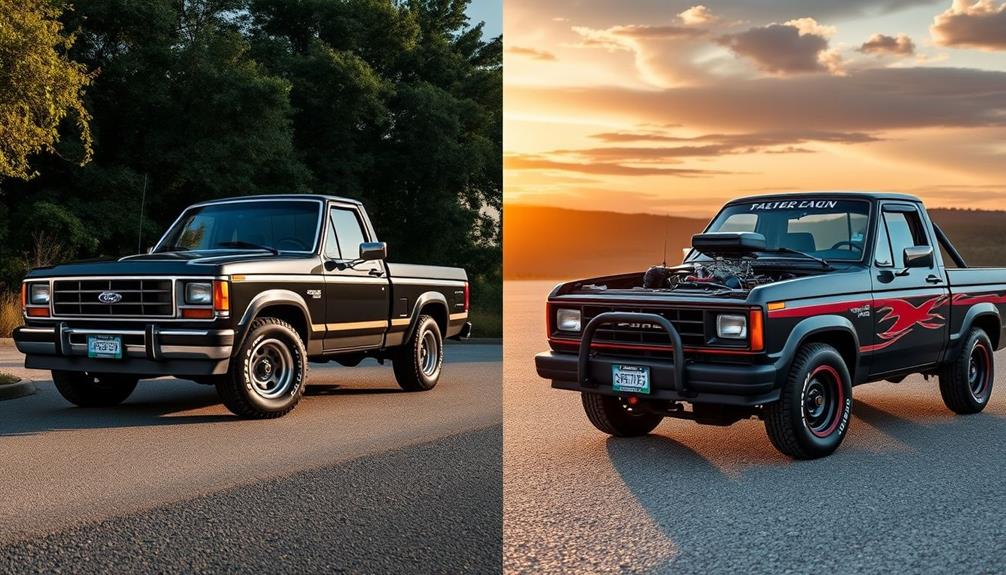
Performance outcomes for the Ford Ranger 1988 show a marked improvement when modifications are made to the engine. By swapping the original 2.0L engine for a more robust 2.3L engine, you can achieve better acceleration and overall performance.
In fact, modified Rangers can rival many V-6 engines, making them a competitive choice in the compact pickup market.
Implementing performance upgrades, such as installing a Weber 32-36 2-barrel carburetor and a 2-barrel intake manifold from a Pinto, can lead to significant increases in horsepower and torque.
With these modifications, your Ranger might even reach approximately 24 MPG in urban settings, showcasing impressive fuel efficiency compared to the original 2.0L engine.
User testimonials consistently highlight that with the right enhancements, including exhaust headers and performance cams, the 2.3L engine delivers a driving experience that exceeds expectations.
Focusing on maximizing air intake and exhaust flow is essential to releasing your Ranger's full potential.
Community Tips and Insights
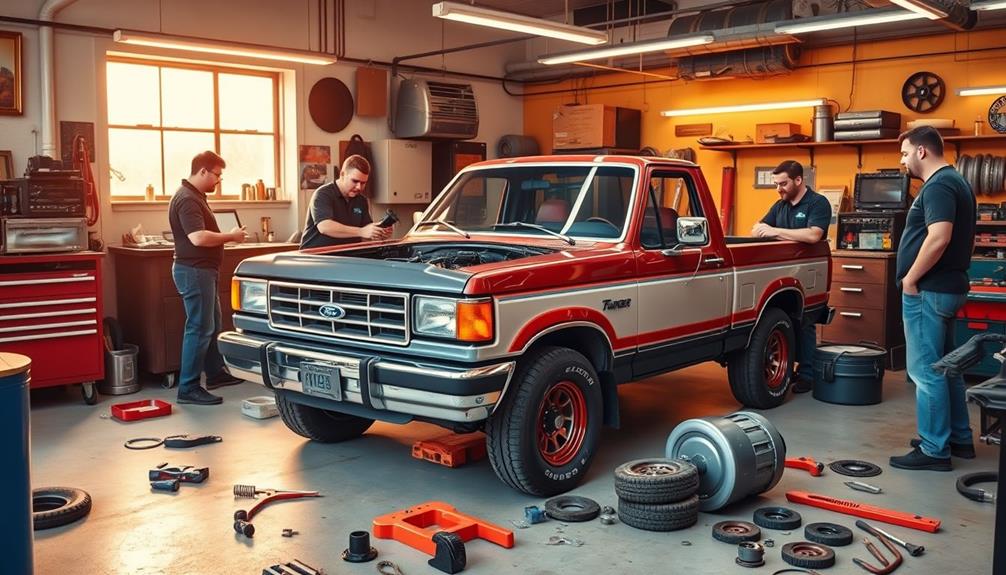
Often, enthusiasts find that engaging with online forums can greatly enhance their tuning journey for the 1988 Ford Ranger.
These platforms are treasure troves of shared experiences, making it easier for you to learn from others' successes and challenges.
Here are some community tips to contemplate as you tune your Ranger:
- Start with simple bolt-on modifications, like a K&N air filter for improved airflow.
- Upgrade to a Weber 32-36 2-barrel carburetor for better fuel delivery and efficiency.
- Think about swapping in headers from other Ranger models or 4-cylinder Mustangs to maximize exhaust flow.
- Pair your upgrades with a Cherry Bomb muffler to enhance sound and performance.
- Collaborate with fellow enthusiasts to brainstorm innovative ideas and stay updated on aftermarket parts.
Future Upgrade Opportunities

Exploring future upgrade opportunities for your 1988 Ford Ranger can take your tuning project to the next level. One of the most effective upgrades is swapping in a 2.3L non-EFI engine from 1983-1985 models. This engine provides a significant boost in torque and horsepower over the original 2.0L. Pair it with a Weber 32-36 carburetor and a 2-barrel intake manifold from a Pinto to enhance fuel delivery and airflow, improving acceleration and efficiency.
Consider adding performance cams specifically designed for the 2.3L engine to maximize power further. A K&N air filter and performance headers can also increase air intake and exhaust flow, resulting in noticeable horsepower gains and an aggressive exhaust note.
Here's a quick overview of potential upgrades:
| Upgrade Type | Benefits | Notes |
|---|---|---|
| 2.3L Non-EFI Engine | Increased torque and horsepower | Significant performance boost |
| Weber 32-36 Carburetor | Improved fuel delivery | Enhances acceleration |
| Performance Cams | Boosts power output | Ideal for performance enthusiasts |
| K&N Air Filter | Better air intake | Enhances engine efficiency |
| Cherry Bomb Muffler | Aggressive sound | Improves exhaust flow |
With these upgrades, you'll elevate your Ranger's performance and driving experience.
Frequently Asked Questions
How Much Horsepower Does a 1988 Ford Ranger 2.3 Have?
The 1988 Ford Ranger with the 2.3L engine produces about 105 horsepower. This marked an improvement over previous models, thanks to its fuel injection system, offering better efficiency and performance for your driving experience.
What Is the Best Year for Ford Ranger Pickups?
When choosing the best year for Ford Ranger pickups, consider your priorities. If you want reliability and solid build, the 1993 model shines. However, the 1997 offers a powerful engine and enhanced safety features.
What Ford Ranger Has the Most Power?
Imagine cruising in a Ford Ranger, the wind in your hair, feeling that raw power. The 1997 Ranger with the 4.0L V6 engine packs the most punch, delivering an exhilarating driving experience that'll leave you smiling.
What Does the PCM Do in a Ford Ranger?
The PCM in your Ford Ranger manages engine performance by controlling fuel injection, ignition timing, and emissions. It uses sensor inputs to optimize efficiency and power, while also storing diagnostic codes for troubleshooting engine issues.
Conclusion
To sum up, tuning your 1988 Ford Ranger can truly transform it into a modern powerhouse. Did you know that with the right modifications, you could boost your Ranger's horsepower by over 50%? By exploring engine swaps and performance upgrades, you not only enhance your driving experience but also connect with a vibrant community of enthusiasts. So, roll up your sleeves, plunge into those modifications, and enjoy every mile in your upgraded classic pickup!



